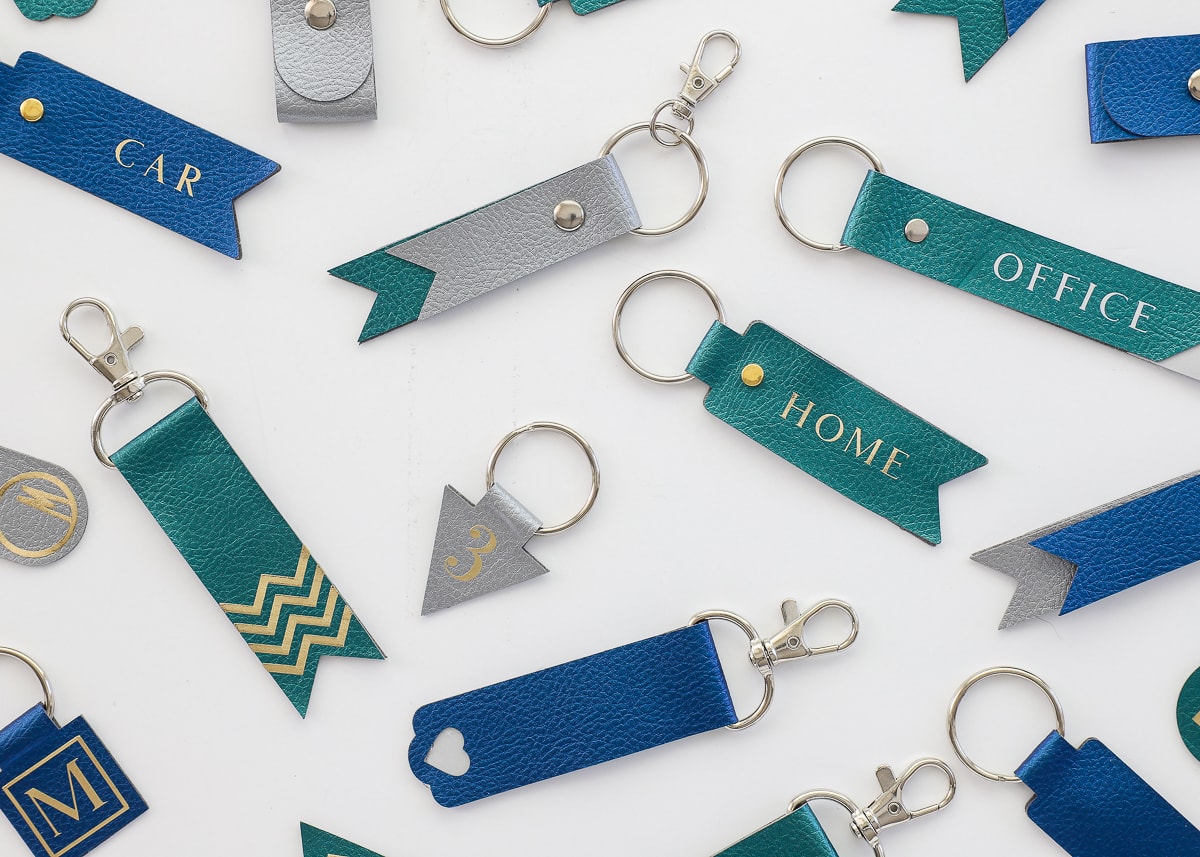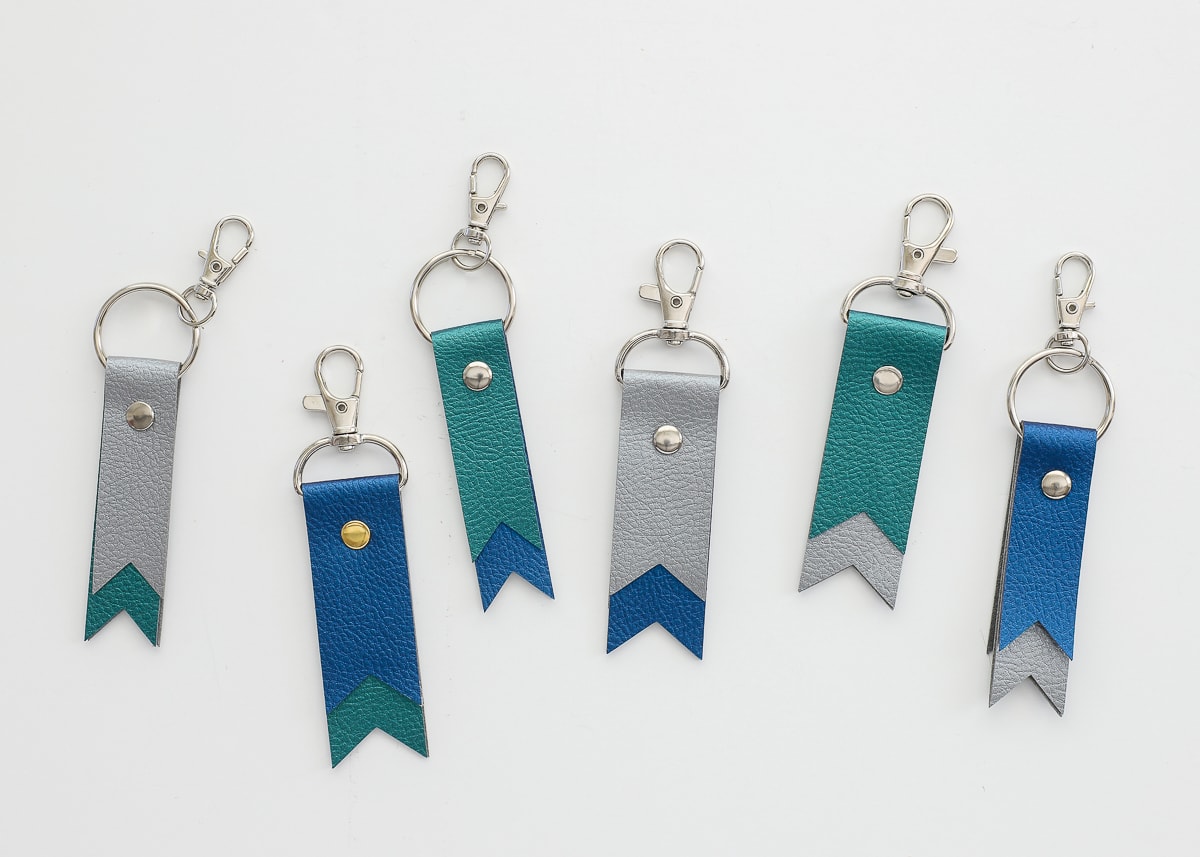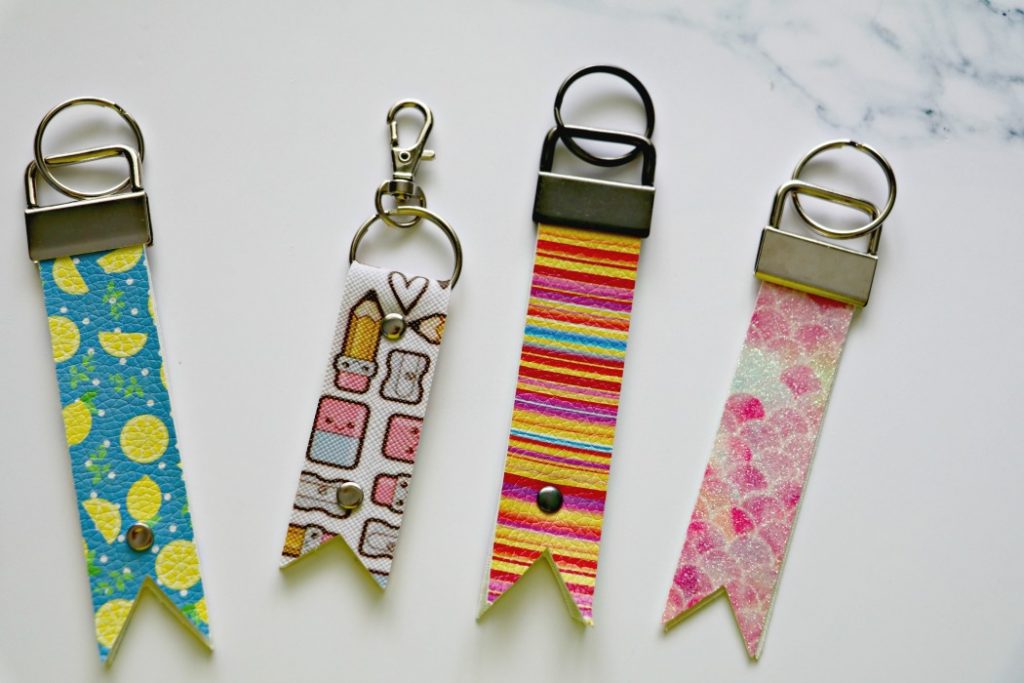Introduction
How To Make Faux Leather Keychain: Crafting your own faux leather keychains offers a wonderful blend of ingenuity and practicality, allowing you to fashion personalized accessories that are both stylish and functional. Faux leather, a versatile and cruelty-free alternative to genuine leather, offers a plethora of possibilities for crafting unique keychains that can reflect your individual style.

Creating faux leather keychains is an engaging and accessible DIY project suitable for both beginners and experienced crafters. This guide will walk you through the step-by-step process of crafting faux leather keychains, from selecting the right materials and tools to mastering techniques that add flair and personality to your designs.
In this creative journey, you’ll explore the art of shaping, cutting, and assembling faux leather pieces to construct keychains that can be personalized with intricate designs, vibrant colors, and embellishments. Whether you’re making these keychains as thoughtful gifts, adding a touch of handmade elegance to your belongings, or simply indulging in a therapeutic crafting session, this guide is your gateway to crafting beautiful and functional faux leather keychains.
So, gather your materials, clear a creative space, and let’s embark on a journey that combines innovation, artistic expression, and hands-on craftsmanship to produce stunning faux leather keychains that you can be proud to carry and showcase.
How do you stamp leather keychain?
Use a leather punch or awl to poke a hole at the top of your tag. Place the leather tag on the stamping block, then stamp in each letter by hammering with a swift downward motion. Pro Tip: If you want to ensure you’re stamping the letters in a straight line, use a piece of tape as a straightedge.
Stamping leather keychains is a creative and satisfying process that allows you to add personalized designs, patterns, and textures to your accessories. Here’s a step-by-step guide on how to stamp leather keychains:
Prepare Your Workspace: Set up a clean and well-lit workspace with all your materials ready. You’ll need your leather keychain blanks, leather stamping tools, a mallet or hammer, and any protective gear.
Choose Stamps: Select the leather stamping tools that match your desired design. Stamps come in various shapes, sizes, and patterns. Consider the overall look you want to achieve and choose stamps accordingly.
Moisten the Leather: Dampen the leather slightly with a damp sponge or cloth. This helps the stamping tools leave a clear and crisp impression on the leather.
Position the Stamp: Place the selected stamp onto the leather keychain blank in the desired location. Make sure it’s aligned properly and centered.
Apply Pressure: Holding the stamp firmly in place, use a mallet or hammer to gently tap the stamping tool. Apply even pressure to create a clear impression. Start with lighter taps and gradually increase pressure if needed.
What thickness leather for keychains?
We use 7 oz tooling leather for our key tags, which means the leather is 7/64” thick. Anything from 6 to 9 oz vegetable tanned leather will work, depending on how firm you want your leather key fob.
When selecting the appropriate thickness of leather for keychains, it’s important to consider both the aesthetic and functional aspects of your design. Keychains experience daily wear and tear, so choosing the right thickness ensures durability while maintaining a polished appearance.
For most keychains, a leather thickness ranging from 2 to 4 ounces (approximately 0.8 to 1.6 millimeters) is commonly recommended. This range strikes a balance between being sturdy enough to withstand daily use and thin enough to be easily cut, shaped, and stamped.
Here’s how the thickness impacts keychain design:
Durability: Thicker leather (closer to 4 ounces) offers greater durability and longevity, making it suitable for keychains that will experience heavy use or rough handling.
Flexibility: Thinner leather (around 2 ounces) provides more flexibility, which is advantageous when adding stamping, embossing, or intricate detailing to your keychain design.
Cutting and Shaping: Thinner leather is easier to cut and shape, allowing you to create various designs and shapes with precision.
What leather should I use for keychains?
A great option for a sturdy keychain is to purchase a 1/2″ lightweight cowhide leather strip. This will yield five or more keychains depending on your desired length. Above you’ll see I’ve painted two and left the center keychain in its natural state.
The choice of leather for keychains depends on factors such as durability, appearance, and your intended design. When selecting leather for keychains, consider these options:
Full-Grain Leather: Full-grain leather is the top layer of the hide, known for its natural texture and strength. It’s a popular choice for keychains due to its durability and ability to age beautifully, developing a unique patina over time.
Top-Grain Leather: Top-grain leather is sanded and refined to remove imperfections, resulting in a smoother surface. It’s still durable and offers a clean look, making it suitable for both classic and modern keychain designs.
Vegetable-Tanned Leather: Vegetable-tanned leather is treated using natural plant-based tannins. It’s versatile and great for stamping, carving, and dyeing, allowing you to customize your keychains with intricate designs.
Chromexcel Leather: Chromexcel leather is known for its rich colors and soft, supple texture. It’s an excellent choice for keychains that require a luxurious appearance and a comfortable feel.
What are most keychains made of?
Most keychains are made from either plastic or metal. However, they can also be made from fabric, paper, wood, or rubber.
Most keychains are made from a variety of materials, each offering unique characteristics that cater to different styles, purposes, and budgets. The choice of material often influences the keychain’s appearance, durability, and functionality. Some common materials used for making keychains include:
Metal: Metal keychains, often made from stainless steel, brass, or aluminum, are highly durable and can withstand everyday wear. They offer a polished and professional look, making them a popular choice for both personal use and promotional items.
Plastic: Plastic keychains are lightweight and cost-effective. They come in various colors and shapes, allowing for creative designs. However, they may not be as durable as other materials and might show signs of wear over time.
Leather: Leather keychains offer a classic and timeless aesthetic. They come in different types of leather, such as full-grain, top-grain, and vegetable-tanned, each with its own texture and appearance. Leather keychains can be stamped, embossed, or dyed for personalization.
Acrylic: Acrylic keychains provide a clear and modern look. They can be custom-cut and have designs printed on them, making them a great choice for showcasing images, logos, or artwork.

What types of faux leather are commonly used for crafting keychains?
Several types of faux leather are commonly used for crafting keychains, each offering different textures, appearances, and characteristics. Here are some popular types of faux leather that you might consider for your keychain projects:
PU Leather (Polyurethane Leather): PU leather is one of the most widely used faux leather materials. It closely mimics the look and feel of genuine leather. It’s available in a variety of colors, textures, and patterns, making it versatile for creating diverse keychain designs.
Vinyl Leather: Vinyl leather is known for its durability and water-resistant properties. It’s a great choice for keychains that may be exposed to moisture or rough handling. Vinyl can come in glossy or matte finishes, allowing for different aesthetics.
Microfiber Leather: Microfiber leather is made from synthetic fibers, often polyamide or polyester. It’s soft, lightweight, and environmentally friendly. Microfiber leather is commonly used for keychains that prioritize comfort and a leather-like appearance.
Cork Leather: Cork leather is made from cork oak bark, offering a unique and sustainable option. It’s lightweight, soft to the touch, and features natural variations in texture and color. Cork leather keychains have an earthy and distinctive look.
Suede Fabric: Suede fabric resembles the texture of suede leather. While not entirely a leather substitute, it offers a tactile and luxurious feel. Suede fabric keychains can be decorated with embroidery, appliqué, or embellishments.
Faux Animal Prints: Some faux leather materials mimic animal prints like snakeskin, alligator, or leopard. These options add a touch of exotic flair to your keychain designs.
How does the process of cutting and shaping faux leather differ from working with other materials?
The process of cutting and shaping faux leather shares similarities with working with other materials, but there are also some distinct considerations due to the nature of faux leather. Here’s how the process may differ when working with faux leather compared to other materials:
Material Thickness and Texture: Faux leather often has a consistent thickness and texture, making it relatively uniform to cut and shape. In contrast, natural materials like fabric or genuine leather can have more variations in thickness and texture, which may require adjustments in cutting techniques.
Clean Cuts: Faux leather generally cuts cleanly with minimal fraying or unraveling. This is in contrast to some fabrics that might require edge finishing to prevent fraying.
Cutting Tools: When cutting faux leather, you can use tools like rotary cutters, utility knives, or scissors. These tools create precise edges without causing excessive damage to the material.
No Grain Direction: Unlike genuine leather, faux leather doesn’t have a natural grain direction. This means you can cut in any direction without worrying about the material’s natural texture affecting the appearance.
Ease of Shaping: Faux leather is often pliable and responsive, making it easy to shape and mold into various designs. This can be advantageous for creating intricate keychain shapes without the challenges that might come with rigid materials.
Finishing Edges: While genuine leather might benefit from edge finishing to prevent fraying, faux leather usually doesn’t require this step due to its synthetic nature.
No Stretching: Faux leather doesn’t stretch like fabrics, allowing for more precise control when cutting and shaping.
What are the benefits and challenges of using faux leather as opposed to genuine leather for crafting keychains?
Using faux leather instead of genuine leather for crafting keychains comes with its own set of benefits and challenges. Here’s an overview of the advantages and considerations when choosing faux leather for your keychain projects:
Benefits of Faux Leather:
Cost-Effective: Faux leather is generally more affordable than genuine leather, making it a budget-friendly option for crafting keychains, especially when making multiple pieces.
Cruelty-Free: Faux leather is a cruelty-free alternative to genuine leather, making it a preferred choice for individuals who prefer not to use animal products.
Consistency: Faux leather is manufactured, resulting in consistent texture, thickness, and appearance across the material. This uniformity can be advantageous for crafting precise and uniform keychains.
Variety: Faux leather comes in a wide range of colors, textures, and patterns, offering a plethora of creative options for crafting unique and personalized keychains.
Water-Resistant: Many faux leather materials are water-resistant or water-repellent, making them suitable for keychains that may be exposed to moisture.
Easy Maintenance: Faux leather is often easier to clean and maintain compared to genuine leather, which might require specialized care to preserve its natural qualities.
How can you maintain the appearance and longevity of faux leather keychains?
Maintaining the appearance and longevity of faux leather keychains requires proper care and attention. While faux leather is durable, it’s important to follow these guidelines to ensure your keychains continue to look their best over time:
Regular Cleaning: Wipe down your faux leather keychains regularly with a soft, damp cloth to remove dust, dirt, and oils. Avoid using abrasive materials that could scratch or damage the surface.
Avoid Harsh Chemicals: Steer clear of harsh cleaning agents, alcohol-based solutions, or bleach, as they can strip the faux leather’s finish and cause discoloration.
Mild Soap Solution: If necessary, use a mild soap solution and a damp cloth to gently clean the surface. Test the solution on a small, inconspicuous area first to ensure it doesn’t affect the faux leather.
Store Properly: When not in use, store your faux leather keychains in a cool, dry place away from direct sunlight. Avoid placing heavy objects on top of them to prevent deformation.
Avoid Water Exposure: While many faux leather materials are water-resistant, it’s best to avoid prolonged exposure to water. If your keychain gets wet, gently pat it dry with a clean cloth and let it air dry naturally.
Protect from Heat: Faux leather can be sensitive to high temperatures, so keep your keychains away from direct heat sources like radiators, heaters, or direct sunlight.
Handle with Care: While faux leather is relatively durable, avoid sharp objects or rough handling that could scratch, tear, or damage the surface.

Conclusion
We’ve explored the steps required to transform faux leather into distinctive and stylish accessories that can enhance your personal style or serve as thoughtful gifts for others. The myriad options that faux leather presents, from its variety of textures and colors to its ease of customization, provide endless avenues for creativity.
Crafting faux leather keychains not only allows you to showcase your artistic prowess but also offers a budget-friendly and ethical alternative to genuine leather. The benefits of faux leather, such as its durability, water resistance, and versatility, make it a prime choice for crafting functional and fashionable accessories.
From cutting and shaping to stamping and embellishing, every stage of the crafting process offers a chance to infuse your unique touch. The ability to experiment with designs, techniques, and finishes lets you create keychains that reflect your individuality and imagination.
As you embark on your journey of crafting faux leather keychains, remember that practice and patience are essential. With each creation, you’ll refine your skills, develop your style, and gain satisfaction from producing pieces that are both visually appealing and enduring. Whether you’re a novice or an experienced crafter, making faux leather keychains is a rewarding endeavor that celebrates innovation, creativity, and the joy of handmade craftsmanship.


